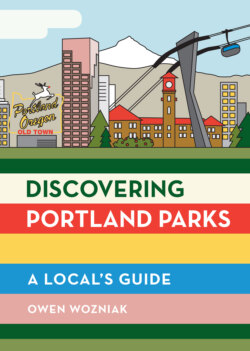Читать книгу Discovering Portland Parks - Owen Wozniak - Страница 10
На сайте Литреса книга снята с продажи.
Оглавление10 FUN FACTS
ABOUT PORTLAND PARKS
| Pioneer Courthouse Square, “Portland’s Living Room” since 1984, changed hands for the first time in 1849. The price: $24 and a pair of boots. | |
| The rose gardens at Washington Park and Peninsula Park are venerable, but for really old roses, visit the Pioneer Rose Garden at the Lone Fir Cemetery. In the 1930s, members of the Pioneer Rose Association roamed the Northwest, collecting cuttings from rose bushes brought across the Oregon Trail by early settlers. The association established four gardens; only the one at Lone Fir remains. | |
| Bogus superlative: Portland claims Forest Park is the “largest, forested natural area within city limits in the United States.” According to the Trust for Public Land, the prize actually goes to Jefferson Memorial Forest in Louisville, Kentucky. A good reason to keep expanding Forest Park! | |
| Actual superlative: Portland’s claim to World’s Smallest Park is legit, according to the Guinness Book of World Records. Mill Ends Park fills a two-foot-diameter traffic island in the middle of SW Front Avenue. | |
| Portland’s most remote city park? That would be Dodge Park, 11 miles east of the city limits. Visit for great fishing, boating, and picnicking. | |
| In 2004, a runner in Forest Park discovered a man and his twelve-year-old daughter living under a tarp. They’d been there four years. The police officer in charge of evicting them noted they seemed happy and healthy, with a Bible, an encyclopedia, and a small vegetable garden. The officer helped them relocate to a friend’s farm nearby, but within a month they vanished again. Their whereabouts remain unknown. | |
| Un-fun fact: Heron Lakes Golf Course and the Portland International Raceway occupy the site of what was once the largest public housing project in American history—Vanport, home to nearly forty thousand shipyard workers during World War II. In 1948, a levee along the Columbia River failed, flooding Vanport and killing fifteen residents and leaving thousands homeless. | |
| Forget about Woodstock. In 1970, the only state-sponsored rock festival in US history took place at Milo McIver State Park on the Clackamas River. Called Vortex I: A Biodegradable Festival of Life, it was devised by Governor Tom McCall as a way to head off potentially violent antiwar protests set to greet President Richard Nixon’s planned Portland visit. The governor tacitly agreed to allow the cops to turn a blind eye to the nudity and weed smoking in exchange for a peaceful week. It worked. | |
| Creepiest park? Kelly Butte Natural Area in Southeast Portland. Atop the overgrown hill is an abandoned bunker, built by the city in 1956 to shelter officials and documents from a nuclear attack. (CBS made a documentary about it titled The Day Called ‘X’.) The bunker proved impractical and the city has since sealed and buried the entrance. | |
| Sick of all the hipster bicyclists and dog lovers? Head to River View Natural Area, where neither is allowed. |
